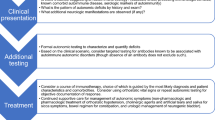Abstract
Spinal dorsal column stimulation has been used in the treatment of a patient with a painful vasospastic condition in the right arm following surgical sympathectomy on the left side. After sympathectomy the left arm became constantly dry and warm and consistently lacked skin vasomotor (laser Doppler flowmetry) responses to arousing stimuli, indicating a complete loss of sympathetic vasomotor innervation. The return of minimal sudomotor (skin resistance) responses to mental stress 2 years after sympathectomy indicated a partial reinnervation of sweat glands. Immediately after sympathectomy, the contralateral right arm became increasingly cold and cyanotic and the patient complained of chronic painful coldness and severe cold-intolerance in the right arm. Attempts to pharmacologically vasodilate the arm with felodipine did not affect the local vasoconstriction and pain. Dorsal column stimulation (associated with symmetrical paraesthesia in both arms) induced an immediate and marked (ten-fold) increase in skin blood flow in the right arm (and in the leg), whereas skin blood flow in the left arm remained unaffected. The lack of vasomotor response in the left arm was not due to maximal vasodilatation at rest, since skin blood flow in the left arm showed a normal capacity for axon reflex vasodilatation following antidromic activation of sensory afferents. The results suggest that the marked vasodilatation induced by dorsal column stimulation is mediated by sympathetic vasomotor fibres, via modulation of central neuronal circuits involved in the regulation of skin sympathetic discharge.
Similar content being viewed by others
References
Cook AW, Oygar A, Baggenstos P, Pacheco S, Kleriga E. Vascular disease of extremities.New York State J Med 1976;76: 366–368.
Meglio M, Cioni B, Dal Lago A, De Sandis M, Pola P, Serricchio M. Pain control and improvement of peripheral blood flow following epidural spinal cord stimulation.J Neurosurg 1981;54: 821–823.
Augustinsson LE, Holm J, Carlsson CA, Jivegård L. Epidural electrical stimulation in severe limb ischaemia. Evidences of pain relief, increased blood flow and a possible limb-saving effect.Ann Surg 1985;202: 104–111.
Groth KE. Spinal cord stimulation for the treatment of peripheral vascular disease. In: Fields HLet al., eds.Advances in Pain Research and Therapy, vol 9. New York: Raven Press, 1985; 861–870.
Tallis RC, Illis LS, Sedgwick EM, Hardwidge C, Garfield JS. Spinal cord stimulation in peripheral vascular disease.J Neurol Neurosurg Psychiatry 1983;46: 478–484.
Linderoth B, Fedorcsak I, Meyerson BA. Is vasodilatation following dorsal column stimulation mediated by antidromic activation of small diameter afferents?Acta Neurochir 1989; (suppl 46): 99–101.
Linderoth B, Fedorcsak I, Meyerson BA. Peripheral vasodilatation after spinal cord stimulation: animal studies of putative effector mechanisms.Neurosurg 1991;28: 187–195.
Illis LS, Sedgwick EM, Tallis RC. Spinal cord stimulation in multiple sclerosis: clinical results.J Neurol Neurosurg Psychiatry 1980;43: 1–14.
Broseta J, Garcia-March G, Sanchez MJ, Goncales J. Influence of spinal cord stimulation on peripheral blood flow.Appl Neurophysiol 1985;48: 367–370.
Hornyak ME, Naver HK, Rydenhag B, Wallin BG. Sympathetic activity influences the vascular axon reflex in the skin.Acta Physiol Scand 1990;139: 77–84.
Lundberg J, Norgren L, Ribbe E, Rosén I, Steen S, Thörne J, Wallin BG. Direct evidence of active sympathetic vasodilatation in the skin of the human foot.J Physiol 1989;417: 437–446.
Rowell LB. Cardiovascular adjustments to thermal stress. In: Shepherd JT, Abboud FM, eds.Handbook of Physiology, section 2: Cardiovascular System, vol. III, Peripheral Circulation and Organ Blood Flow, part 2. Bethesda, MD: American Physiological Society, 1983; 967–1023.
Elam M, Wallin BG. Skin blood flow responses to mental stress in man depend on body temperature.Acta Physiol Scand 1987:129: 489–497.
Oberle J, Elam M, Karlsson T, Wallin BG. Temperature dependent interaction between vasoconstrictor and vasodilator mechanisms in human skin.Acta Physiol Scand 1988;132: 459–469.
Author information
Authors and Affiliations
Rights and permissions
About this article
Cite this article
Naver, H., Augustinsson, LE. & Elam, M. The vasodilating effect of spinal dorsal column stimulation is mediated by sympathetic nerves. Clinical Autonomic Research 2, 41–45 (1992). https://doi.org/10.1007/BF01824210
Received:
Accepted:
Issue Date:
DOI: https://doi.org/10.1007/BF01824210




